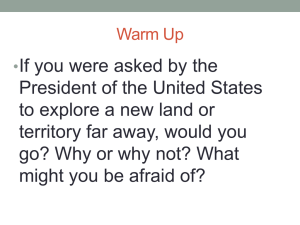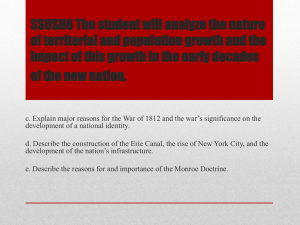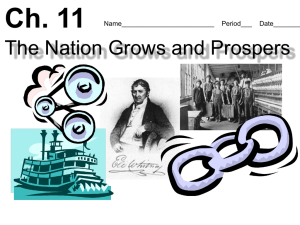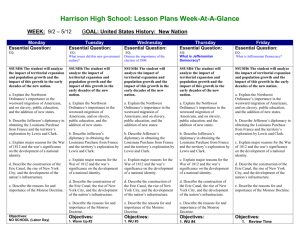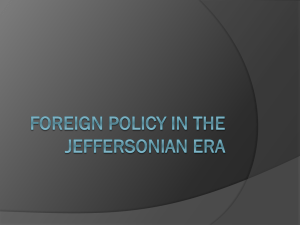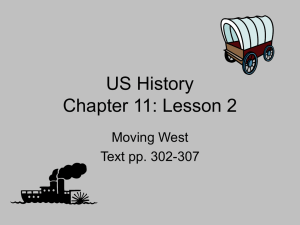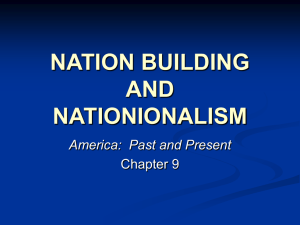Standard 6 PP - Polk School District
advertisement
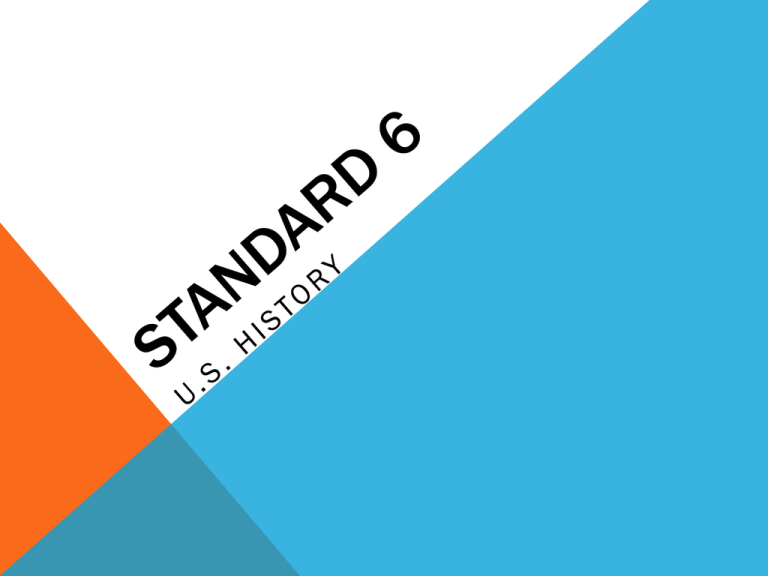
STANDARD 6 The student will analyze the impact of territorial expansion and population growth and the impact of this growth in the early decades of the new nation. NORTHWEST ORDINANCE The first U.S. governmental territory outside the original states was the Northwest Territory, which was created by the Northwest Ordinance. This law demonstrated to Americans that their national government intended to encourage westward expansion and that it would do so by organizing new states that would be equal members of the Union. The ordinance banned slavery in the Northwest Territory. This law made the Ohio River the boundary between free and slave regions between the 13 states and the Mississippi River. Additionally, the Northwest Ordinance mandated the establishment of public schools in the Northwest Territory. LOUISIANA PURCHASE In the early 1800s, President Thomas Jefferson sent James Monroe to France to negotiate the purchase of the important port city of New Orleans. At the time, the French ruler Napoleon controlled New Orleans and much of the land west of the Mississippi River. In 1803, Napoleon agreed to sell to the United States not only New Orleans but also the entire Louisiana Territory for $15 million. As a result, the United States nearly doubled in geographic area. LEWIS AND CLARK Jefferson sent Meriwether Lewis and William Clark to explore Louisiana and the western lands all the way to the Pacific Ocean. On their 16-month expedition, Lewis and Clark charted the trails west, mapped rivers and mountain ranges, wrote descriptions and collected samples of unfamiliar animals and plants, and recorded facts and figures about the various Native American tribes and customs west of the Mississippi River. WAR OF 1812: CAUSES In 1812, America declared war on Great Britain, which was already at war with France. Among the causes of this war, four stand out. First, Americans objected to restrictions Britain was enforcing to prevent neutral American merchants from trading with the French. Second, Americans were outraged by the British policy of impressment. Under this policy, thousands of American sailors were forced against their will to serve in the British navy after their merchant ships were captured at sea. Third, Americans suspected the British were giving military support to Native Americans so they would fight to keep Americans from settling lands west of the Appalachian Mountains. Fourth, Americans wished to drive the British out of North America altogether by conquering Canada while the British army was fighting the French in Europe. WAR OF 1812: RESULTS A major result of the War of 1812 was the end of all U.S. military hostility with Great Britain. Never again would Britain and the United States wage war over diplomacy, trade, territory, or any other kind of dispute. America’s army and navy were firmly established as worthy opponents of any European military force. The U.S. military’s achievements in the War of 1812 also served to heighten nationalist sentiments. NATIONAL INFRASTRUCTURE In this period, many families moved west of the Appalachian Mountains to claim land in the new American territories stretching to the Mississippi River. Their travel was difficult, taking a week to cross the distance a car might drive today in a few hours. In response, private companies built the young nation’s roads and waterways. These roads were often turnpikes, or toll roads, which travelers paid a fee to use. NATIONAL INFRASTRUCTURE In turn, these fees were used to pay for upkeep of the new roads. Where roads could not be built, barges were used on rivers to carry people and goods––as long as the rivers flowed in the same direction that the settlers and merchants wanted to travel. Soon a new invention, thesteamboat, enabled people to buy a ticket from private companies that operated the boats and to travel upstream as easily as downstream. NATIONAL INFRASTRUCTURE Lastly, in the wilderness where rivers did not run and roads could not be built, government leaders joined business people to build canals––artificial rivers. These shallow waterways were for barges, not steamboats, and had pathways alongside on which horses or mules pulled the barges. ERIE CANAL The most famous canal built in this era was the Erie Canal, which connected the Great Lakes to the Atlantic Ocean. It was opened in 1825 after eight years of digging by thousands of laborers, mostly immigrants. It stretches 363 miles from Lake Erie to the Hudson River, which flows into the Atlantic Ocean at New York City. The Erie Canal served as a turnpike for barges where a road could not easily be built, and greatly lowered transportation costs. This not only opened up western New York and regions further west to increased settlement, but also helped unite new regions with the Atlantic states. RISE OF NEW YORK CITY Until 1790, New York City was the capital of the United States. In the early 1800s, civic development turned this colonial town into a great economic center established on a grid of city blocks. By 1835, the population had grown so large that New York City outpaced Philadelphia as the largest U.S. city. Trade grew when the Erie Canal made the city’s harbors the link between European merchants and the great agricultural markets across the Appalachians from New York City. The city was home to the biggest gathering of artisans and crafts workers in the United States, and its banking and commercial activities would soon make it the leading city in all of North America. MONROE DOCTRINE In 1823, President James Monroe warned the nations of Europe not to meddle in the politics of North and South America. When a group of European countries planned to help one another recapture American colonies that had gained independence, Monroe announced that the United States would prevent European nations from interfering with independent American countries. Further, Monroe said the United States would remain neutral in wars between European nations and their American colonies, but, if battles took place in the New World, the United States would view such battles as hostile actions against the United States. In summary, the Monroe Doctrine defined an aspect of U.S. foreign policy to which America still holds today.
